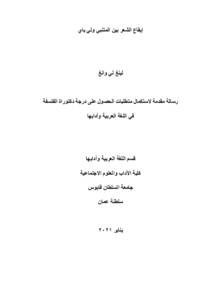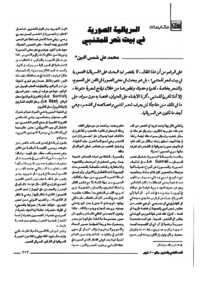Document
إيقاع الشعر بين المتنبئ ولي باي.
Other titles
Poetry Rhythm Between Al-Mutanabbi And Li Bai Lingli Wang
Publisher
جامعة السلطان قابوس.
Gregorian
2021
Language
Arabic
English abstract
Abstract
Rhythm is a fundamental principle of natural being and a common
characteristic among all the arts, and it is the basis on which any work of
literature and art is based. This fact justifies the study of poetry rhythm
between Al-Mutanabbi and Li Bai, which aims to go into the Arabic and
Chinese poetries to describe the manifestations of rhythm in both of them
and to reveal the similarities and differences between them. To answer
these questions, we ascertained the rhythmic structure in poetry based on
previous studies, and had Al-Mutanabbi and Li Bai to be the representa tives of the two poetries, and lined up from both collections of several pairs
of poems as samples, provided that they are different in prosodic structure
and typical of their form and each pair of them with the same subject. We
described the manifestations of rhythm in these samples and analyzed it
from two fields: one is traditional prosody, another is rhetorical arts, then
we reached some results, the most important of which are:
1- The rhythm of poetry includes the external rhythm and internal
rhythm.The external rhythm is derived from the external characteristics of
the poetic language, and it has two aspects: one is the auditory rhythm that
IX
is derived from the phonological characteristics of the language, including
the prosodic rhythm and the free rhythm and what the verbal rhetorical arts
contribute to, and the other is the visual rhythm that is derived from the
written images of the poetic language; and internal rhythm contains the
moral rhythm that results from the repetition of meaning and the rhetorical
arts that relate to repetition, and emotional rhythm that stems from the
eruption of emotion in poetry as it follows the moral rhythm, but they are
not united at all times.
2- In terms of the external rhythm, the Arabic and Chinese poetries
coincide in the formation of the prosodic rhythm from three circles: the
organization, the metre and the rhyme, but they differ in the composition of
these circles, and they agree in enhancing the external rhythm through the
contrived arts; and in the aspect of the internal rhythm, they agree to
achieve and strengthen it by distributing diffterent sentences and unites and
contrived arts, but both of them have preference for some of these arts and
deviation from others due to the characteristics of the two languages
Member of
Resource URL
Arabic abstract
الإيقاع مبدأ أساسي للكيان الطبيعي وصفة مشتركة بين الفنون جميعا وهو بمثابة القاعدة التي يقوم عليها أي عمل من أعمال الأدب والفن. هذه الحقيقة تسوّغ دراساتنا في موضوع إيقاع الشعر بين المتنبي و" لي باي" وهي تهدف إلى الوقوف على الشعرين العربي والصيني لوصف مظاهر الإيقاع فيهما وكشف أوجه التماثل والتخالف منها بينهما. وللإجابة عن هذه الأسئلة قمنا بتحديد البنية الإيقاعية في الشعر مسنتدا إلى الدراسات السابقة، وجعلنا المتنبي و"لي باي" ممثّلي الشعرين واصطفينا من ديوانهما عدّة أزواج من العينات على أن تكون مختلفة البنية العروضية وممثّلة لصيغتها وكل زوج منها بنفس الغرض، ووصفنا المظاهر الإيقاعية في هذه العينات وحلّلناها من مجالين مجال علم العروض التقليدي ومجال الفنون البلاغية، وتوصّلنا إلى نتائج قيمة والأهم منها:
1- إيقاع الشعر يتضمن الإيقاع الخارجي الذي يتسبّب من الخصائص الخارجية للغة الشعرية، وله جانبان، أحدهما الإيقاع السمعي الذي ينتج عن الخصائص الصوتية اللغوية ويضم الإيقاع العروضي والإيقاع الحر وتسهم فيه الفنون البلاغية اللفظية، والآخر الإيقاع المرئي الذي ينجم عن الصور الكتابية للغة الشعرية؛ والإيقاع الداخلي وهو يحوي الإيقاع المعنوي الذي يترتّب عن تكرار المعنى وتسهم فيه الفنون البلاغية التي تتعلق بالتكرار والإيقاع العاطفي الذي ينتج عن تموّج العاطفة في الشعر وهو يتّبع للإيقاع المعنوي لكنهما ليسا متحدين في كل الأحيان.
2- في ناحية الإيقاع الخارجي يتوافق الشعران العربي والصيني في تشكّل الإيقاع العروضي من ثلاث دوائر وهي النظم والوزن والقافية غير أنهما يتفارقان في مكوّنات هذه الدوائر، ويتّفقان في تعزيز الإيقاع الخارجي بواسطة الفنون الصناعية؛ وفي ناحية الإيقاع الداخلي يتفقان في تحقيقه وتقويته من خلال توزيع الجمل والأنساق والفنون الصناعية، غير أن لكلاهما تفضيل على بعض من هذه الفنون وانزياح عن البعض الآخر نظرا لخصائص اللغتين
1- إيقاع الشعر يتضمن الإيقاع الخارجي الذي يتسبّب من الخصائص الخارجية للغة الشعرية، وله جانبان، أحدهما الإيقاع السمعي الذي ينتج عن الخصائص الصوتية اللغوية ويضم الإيقاع العروضي والإيقاع الحر وتسهم فيه الفنون البلاغية اللفظية، والآخر الإيقاع المرئي الذي ينجم عن الصور الكتابية للغة الشعرية؛ والإيقاع الداخلي وهو يحوي الإيقاع المعنوي الذي يترتّب عن تكرار المعنى وتسهم فيه الفنون البلاغية التي تتعلق بالتكرار والإيقاع العاطفي الذي ينتج عن تموّج العاطفة في الشعر وهو يتّبع للإيقاع المعنوي لكنهما ليسا متحدين في كل الأحيان.
2- في ناحية الإيقاع الخارجي يتوافق الشعران العربي والصيني في تشكّل الإيقاع العروضي من ثلاث دوائر وهي النظم والوزن والقافية غير أنهما يتفارقان في مكوّنات هذه الدوائر، ويتّفقان في تعزيز الإيقاع الخارجي بواسطة الفنون الصناعية؛ وفي ناحية الإيقاع الداخلي يتفقان في تحقيقه وتقويته من خلال توزيع الجمل والأنساق والفنون الصناعية، غير أن لكلاهما تفضيل على بعض من هذه الفنون وانزياح عن البعض الآخر نظرا لخصائص اللغتين
Category
Theses and Dissertations



